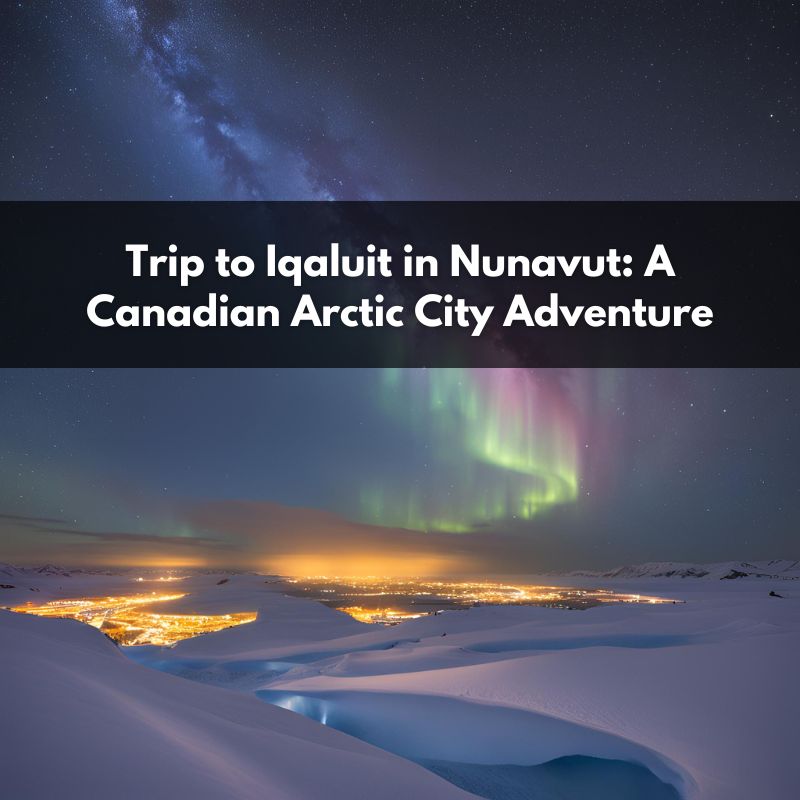
Exploring the Canadian Arctic is a dream for many adventurers, and a trip to Iqaluit, the capital of Nunavut, offers a unique and unforgettable experience. Iqaluit, located on Baffin Island, is not just a gateway to the Arctic but also a vibrant city rich in Inuit culture, stunning landscapes, and fascinating history. This guide will help you plan your trip to Iqaluit, ensuring you make the most of your journey to this remote yet captivating Canadian Arctic city.
1. Getting to Iqaluit
Traveling to Iqaluit is an adventure in itself. The city is accessible primarily by air, with flights available from major Canadian cities like Ottawa, Montreal, and Yellowknife. Since there are no roads connecting Iqaluit to other parts of Canada, flying is the most practical and common way to reach the city.
- Flights: Regular flights are offered by airlines such as Canadian North and First Air. It’s advisable to book your tickets well in advance, as flights can fill up quickly, especially during peak travel seasons.
- Seasonal Considerations: Depending on the time of year, your flight experience may vary. Winter flights might offer spectacular views of the icy Arctic landscape, while summer flights provide a chance to see the midnight sun.
2. Exploring Iqaluit: Top Attractions
Iqaluit offers a mix of cultural and natural attractions that showcase the uniqueness of the Arctic. Here are some must-visit places during your trip:
- Nunatta Sunakkutaangit Museum: This museum is a great starting point to learn about Inuit culture and history. It houses a collection of artifacts, artwork, and exhibits that provide insight into the traditional and contemporary lives of the Inuit people.
- St. Jude’s Anglican Cathedral: Also known as the “Igloo Cathedral,” this iconic building is one of the most recognizable landmarks in Iqaluit. Its unique igloo-shaped design reflects the architectural style of the Arctic.
- Sylvia Grinnell Territorial Park: Just a short drive from the city, this park offers stunning views of the tundra, rivers, and wildlife. It’s a great spot for hiking, birdwatching, and enjoying the serene Arctic environment.
- Frobisher Bay: Named after the English navigator Martin Frobisher, this bay offers breathtaking views and opportunities for boating and kayaking during the summer months. In the winter, the frozen bay becomes a playground for snowmobiling and ice fishing.
3. Embracing Inuit Culture
Iqaluit is deeply rooted in Inuit culture, and visitors have the opportunity to immerse themselves in traditional practices and customs.
- Inuit Art and Craft: Iqaluit is home to many talented Inuit artists. Visit local galleries and shops to see and purchase exquisite carvings, prints, and textiles that reflect the rich artistic heritage of the Inuit people.
- Cultural Events: Depending on the time of your visit, you might experience traditional Inuit celebrations, such as the Toonik Tyme Festival in April. This festival includes dog sledding races, traditional games, and performances that highlight Inuit culture.
- Local Cuisine: Don’t miss the chance to try traditional Inuit dishes such as Arctic char, seal, and bannock. Many local restaurants offer a blend of traditional and contemporary Arctic cuisine, giving you a taste of the North.
4. Experiencing the Arctic Wilderness
The natural beauty of Iqaluit and its surroundings is one of the main draws for visitors. The Arctic landscape is both breathtaking and humbling, offering a variety of outdoor activities for nature enthusiasts.
- Aurora Borealis (Northern Lights): If you visit Iqaluit during the winter months, you may be treated to the mesmerizing display of the Northern Lights. The dark, clear skies of the Arctic provide the perfect backdrop for this natural phenomenon.
- Dog Sledding: Experience the thrill of dog sledding, a traditional mode of transportation in the Arctic. Several local operators offer guided dog sledding tours that allow you to explore the snowy landscapes while learning about this ancient practice.
- Hiking and Wildlife Viewing: The tundra around Iqaluit is home to a variety of wildlife, including caribou, Arctic foxes, and migratory birds. Hiking in the area can be an incredible way to connect with the natural world and observe these animals in their native habitat.
5. Practical Tips for Visiting Iqaluit
Traveling to Iqaluit requires some preparation, especially given its remote location and unique environment. Here are a few practical tips to ensure your trip goes smoothly:
- Clothing: Dress in layers, as temperatures can vary significantly, even in the summer. Winter gear is essential if visiting in colder months, including insulated jackets, boots, gloves, and hats.
- Local Etiquette: Respect for Inuit culture is paramount. Be mindful of local customs, seek permission before taking photos of people, and support local businesses and artisans.
- Transportation: While Iqaluit is relatively small, getting around on foot is possible. Taxis are available, but be aware that transportation options are limited compared to larger cities.
- Communication: English and Inuktitut are the official languages, so knowing a few basic phrases in Inuktitut can be appreciated by locals.
- Weather: The Arctic climate can be unpredictable, so always check the weather forecast and be prepared for sudden changes.
6. Why Visit Iqaluit?
A trip to Iqaluit is more than just a vacation; it’s an exploration of one of the most unique and culturally rich regions of Canada. Whether you’re drawn by the allure of the Arctic wilderness, the opportunity to learn about Inuit culture, or the chance to see the Northern Lights, Iqaluit offers an experience unlike any other.
Visiting Iqaluit provides a rare glimpse into life in the Arctic, where tradition and modernity coexist in a fascinating blend. The city’s warmth, despite its cold climate, is found in its people, culture, and community spirit. It’s a destination for those seeking adventure, learning, and a deeper understanding of the world’s northernmost reaches.
Conclusion
Iqaluit, Nunavut’s capital, is a city that captivates with its raw natural beauty, rich cultural heritage, and the unique charm of Arctic life. Whether you’re an adventurer, a cultural enthusiast, or simply someone looking to experience something truly different, a trip to Iqaluit will leave you with memories of a lifetime. Embrace the Arctic, discover the heart of Inuit culture, and let the stunning landscapes of Iqaluit inspire your next adventure.
